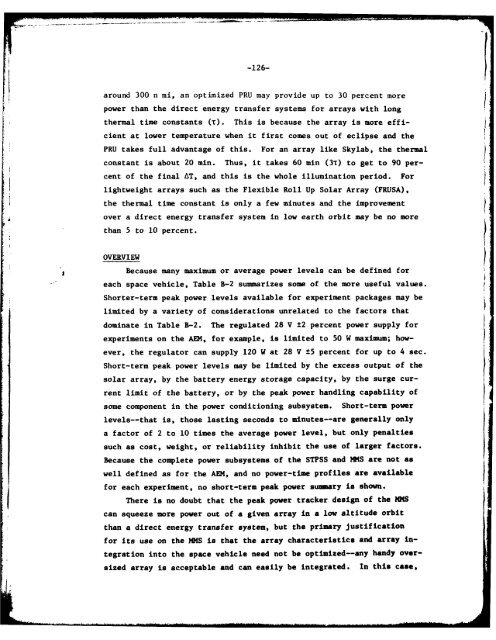A Case Study in NASA-DoD - The Black Vault
A Case Study in NASA-DoD - The Black Vault
A Case Study in NASA-DoD - The Black Vault
You also want an ePaper? Increase the reach of your titles
YUMPU automatically turns print PDFs into web optimized ePapers that Google loves.
-126-<br />
around 300 n mi, an optimized PRU may provide up to 30 percent more<br />
power than the direct energy transfer systems for arrays with long<br />
thermal time constants (T). This is because the array is more efficient<br />
at lower temperature when it first comes out of eclipse and the<br />
PRU takes full advantage of this. For an array like Skylab, the thermal<br />
constant is about 20 m<strong>in</strong>. Thus, it takes 60 m<strong>in</strong> (3T) to get to 90 percent<br />
of the f<strong>in</strong>al AT, and this is the whole illum<strong>in</strong>ation period. For<br />
lightweight arrays such as the Flexible Roll Up Solar Array (FRUSA),<br />
the thermal time constant is only a few m<strong>in</strong>utes and the improvement<br />
over a direct energy transfer system <strong>in</strong> low earth orbit may be no more<br />
than 5 to 10 percent.<br />
OVERVIEW<br />
Because many maximum or average power levels can be def<strong>in</strong>ed for<br />
each space vehicle, Table B-2 summarizes some of the more useful values.<br />
Shorter-term peak power levels available for experiment packages may be<br />
limited by a variety of considerations unrelated to the factors that<br />
dom<strong>in</strong>ate <strong>in</strong> Table B-2. <strong>The</strong> regulated 28 V ±2 percent power supply for<br />
experiments on the AEM, for example, is limited to 50 W maximum; however,<br />
the regulator can supply 120 W at 28 V ±5 percent for up to 4 sec.<br />
Short-term peak power levels may be limited by the excess output of the<br />
solar array, by the battery energy storage capacity, by the surge current<br />
limit of the battery, or by the peak power handl<strong>in</strong>g capability of<br />
some component <strong>in</strong> the power condition<strong>in</strong>g subsystem. Short-term power<br />
levels--that is, those last<strong>in</strong>g seconds to m<strong>in</strong>utes--are generally only<br />
a factor of 2 to 10 times the average power level, but only penalties<br />
such as cost, weight, or reliability <strong>in</strong>hibit the use of larger factors.<br />
Because the complete power subsystems of the STPSS and MS are not as<br />
well def<strong>in</strong>ed as for the AEM, and no power-time profiles are available<br />
for each experiment, no short-term peak power summary is shown.<br />
<strong>The</strong>re is no doubt that the peak power tracker design of the MKS<br />
can squeeze more power out of a given array <strong>in</strong> a low altitude orbit<br />
than a direct energy transfer system, but the primary justification<br />
for its use on the IMS is that the array characteristics and array <strong>in</strong>tegration<br />
<strong>in</strong>to the space vehicle need not be optimized--any handy oversized<br />
array is acceptable and can easily be <strong>in</strong>tegrated. In this case,
















